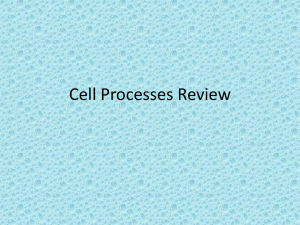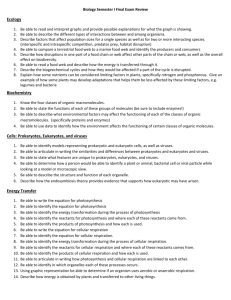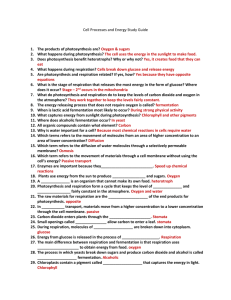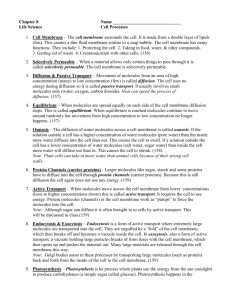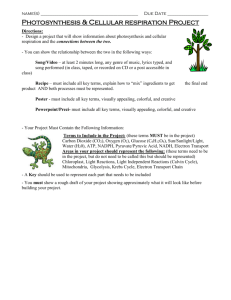SS_Phtosynthesis and Cellular Respiration
advertisement
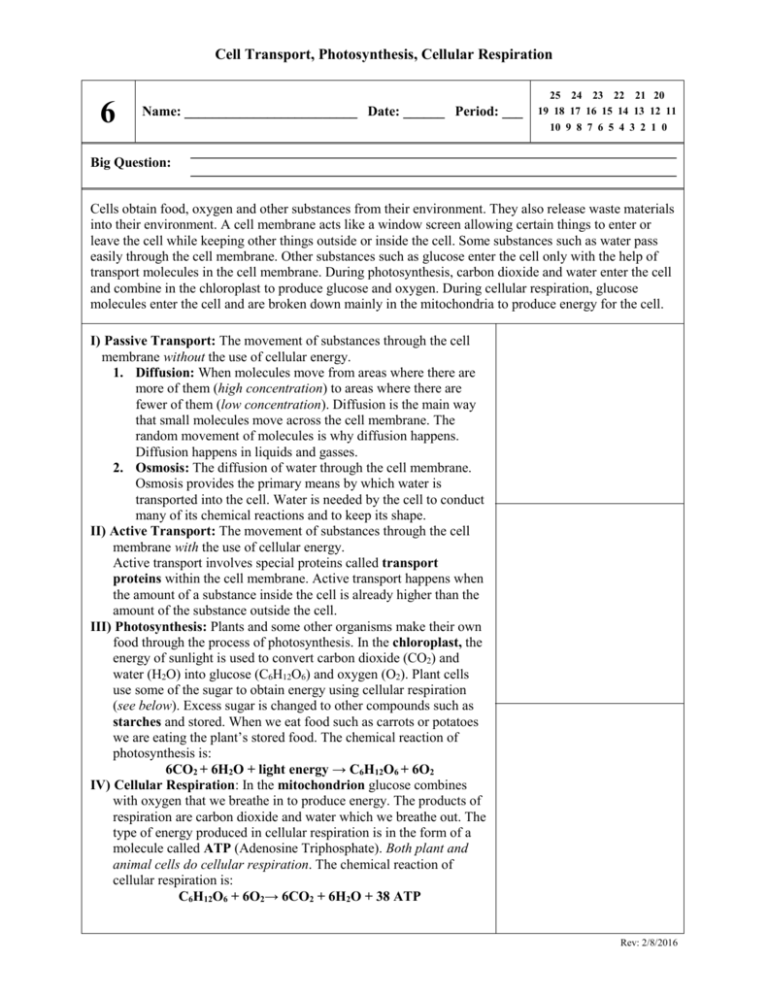
Cell Transport, Photosynthesis, Cellular Respiration 6 Name: _________________________ Date: ______ Period: ___ 25 24 23 22 21 20 19 18 17 16 15 14 13 12 11 10 9 8 7 6 5 4 3 2 1 0 Big Question: Cells obtain food, oxygen and other substances from their environment. They also release waste materials into their environment. A cell membrane acts like a window screen allowing certain things to enter or leave the cell while keeping other things outside or inside the cell. Some substances such as water pass easily through the cell membrane. Other substances such as glucose enter the cell only with the help of transport molecules in the cell membrane. During photosynthesis, carbon dioxide and water enter the cell and combine in the chloroplast to produce glucose and oxygen. During cellular respiration, glucose molecules enter the cell and are broken down mainly in the mitochondria to produce energy for the cell. I) Passive Transport: The movement of substances through the cell membrane without the use of cellular energy. 1. Diffusion: When molecules move from areas where there are more of them (high concentration) to areas where there are fewer of them (low concentration). Diffusion is the main way that small molecules move across the cell membrane. The random movement of molecules is why diffusion happens. Diffusion happens in liquids and gasses. 2. Osmosis: The diffusion of water through the cell membrane. Osmosis provides the primary means by which water is transported into the cell. Water is needed by the cell to conduct many of its chemical reactions and to keep its shape. II) Active Transport: The movement of substances through the cell membrane with the use of cellular energy. Active transport involves special proteins called transport proteins within the cell membrane. Active transport happens when the amount of a substance inside the cell is already higher than the amount of the substance outside the cell. III) Photosynthesis: Plants and some other organisms make their own food through the process of photosynthesis. In the chloroplast, the energy of sunlight is used to convert carbon dioxide (CO2) and water (H2O) into glucose (C6H12O6) and oxygen (O2). Plant cells use some of the sugar to obtain energy using cellular respiration (see below). Excess sugar is changed to other compounds such as starches and stored. When we eat food such as carrots or potatoes we are eating the plant’s stored food. The chemical reaction of photosynthesis is: 6CO2 + 6H2O + light energy → C6H12O6 + 6O2 IV) Cellular Respiration: In the mitochondrion glucose combines with oxygen that we breathe in to produce energy. The products of respiration are carbon dioxide and water which we breathe out. The type of energy produced in cellular respiration is in the form of a molecule called ATP (Adenosine Triphosphate). Both plant and animal cells do cellular respiration. The chemical reaction of cellular respiration is: C6H12O6 + 6O2→ 6CO2 + 6H2O + 38 ATP Rev: 2/8/2016 Cell Transport, Photosynthesis, Cellular Respiration 1. In the process of photosynthesis, plants use the energy in ________________________________ to make food. 2. True or False? Besides the energy in sunlight, the cell needs water and carbon dioxide to make glucose. 3. Circle the letter of each product of photosynthesis. a. water b. carbon dioxide c. oxygen d. sugar 4. Write the chemical equation for the process of photosynthesis: Write the chemical equation for the process of cellular respiration: 6. Cells create energy in the form of ____________________. Moving materials through a cell membrane without using energy is called _______________ transport. 5. _____________________________________________ _____________________________________________ 7. In diffusion, molecules move from an area of _______________________concentration to an area of ____________________concentration. 8. 9. Circle the letter of how water moves in osmosis. a. across a cell membrane b. to areas where there is more water 10. Cells use energy to move substances through the cell membrane in _________________transport. 10 9 8 7 6 5 4 3 2 1 0 Mini-Essay (10 pts) Read, Understand, and Answer: Suppose a volcano threw so much ash into the air that it blocked most of the sunlight that usually strikes the earth. How might this affect the ability of animals to obtain food? Explain using the concepts of photosynthesis and cellular respiration. ______________________________________________________________________________ ______________________________________________________________________________ ______________________________________________________________________________ ______________________________________________________________________________ ______________________________________________________________________________ ______________________________________________________________________________ ______________________________________________________________________________ ______________________________________________________________________________ ______________________________________________________________________________ ______________________________________________________________________________ ______________________________________________________________________________ ______________________________________________________________________________ ______________________________________________________________________________ Self: 10 9 8 7 6 5 4 3 2 1 0 Other: 10 9 8 7 6 5 4 3 2 1 0 Honest and fair self-evaluation helps you improve. You are evaluating the work of the person NOT the person. If your handwriting is hard to read, maximum score is 5. You can type your essay and paste in the space. Rev: 2/8/2016




